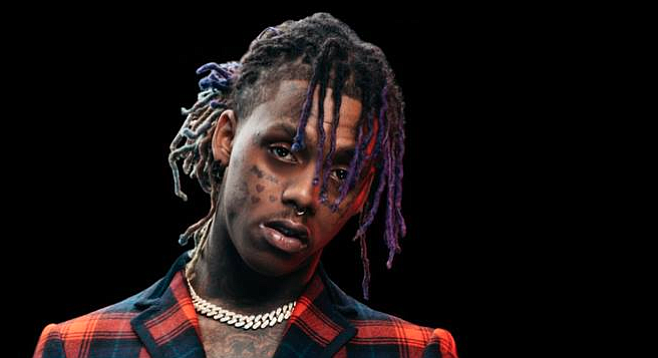 Facebook
Facebook
 X
X
 Instagram
Instagram
 TikTok
TikTok
 Youtube
Youtube

After 32 years, San Diego County’s second oldest live music venue (after the Belly Up Tavern) is making a major change to its format.
SOMA owner Len Paul says hip-hop matters more to his underage clientele, and his all-age music showcase has adapted to the trend. “The popularity of the hardcore, pop-punk, emo, screamo genres has diminished and it's being replaced with hip-hop,” Paul tells the Reader.
While he makes it clear that bands with an electric guitar will still be playing at his Sports Arena-adjacent showcase, he says it’s the rap that he says now really moves the kids.
SOMA launched downtown in 1986 then moved to Bay Park in 1994. The venue moved to its current venue in an abandoned multiplex movie theater 16 years ago, and now features a 2000-capacity main room and a 300-capacity side stage. “We have always tried to be flexible to what the younger music fan likes,” says Paul. “Everything goes in cycles.”
And that cycle, he says, is now all about Kendrick Lamar. “I noticed it starting to happen in the middle of last year,” says Paul. “That’s when hip-hop really started crossing over into the mainstream pop culture. The only kind of rock that is still consistently popular across the board is indie rock, and that is because it appeals to the slightly older crowd.”
With hip-hop often comes rowdy crowd behavior, but Paul says, “Every hip-hop show we’ve done has been infinitely less problematic than any hardcore or punk show we’ve ever done.” He says the automatic reaction against hip-hop reminds him of the '80s when he hosted pioneering mohawked, pierced, leather-clad punk bands. “The [rap] music by its very nature is anarchistic. Just like the old punk rock, there is a lot of fear that people have about it. Just like the days days of Elvis when rock and roll first started, mainstream culture thought the world was going to fall apart.”
And while he admits rap can be overtly profane, he believes it deserves respect. “There is lyrical rhyme that requires detail. It’s a complex expression of our culture.”
Paul works with San Diego Police Department in advance on a show-by-show basis to try to head off problems. He says his direct contact, detective Robert Stinson, represents a new generation of police leaders who do not reject rap just because it’s rap. “These guys are the younger generation who grew up knowing that rap is part of our culture and should not automatically be rejected. We work very closely with [SDPD] Vice to make sure any of the artists don’t have gang affiliations.”


After 32 years, San Diego County’s second oldest live music venue (after the Belly Up Tavern) is making a major change to its format.
SOMA owner Len Paul says hip-hop matters more to his underage clientele, and his all-age music showcase has adapted to the trend. “The popularity of the hardcore, pop-punk, emo, screamo genres has diminished and it's being replaced with hip-hop,” Paul tells the Reader.
While he makes it clear that bands with an electric guitar will still be playing at his Sports Arena-adjacent showcase, he says it’s the rap that he says now really moves the kids.
SOMA launched downtown in 1986 then moved to Bay Park in 1994. The venue moved to its current venue in an abandoned multiplex movie theater 16 years ago, and now features a 2000-capacity main room and a 300-capacity side stage. “We have always tried to be flexible to what the younger music fan likes,” says Paul. “Everything goes in cycles.”
And that cycle, he says, is now all about Kendrick Lamar. “I noticed it starting to happen in the middle of last year,” says Paul. “That’s when hip-hop really started crossing over into the mainstream pop culture. The only kind of rock that is still consistently popular across the board is indie rock, and that is because it appeals to the slightly older crowd.”
With hip-hop often comes rowdy crowd behavior, but Paul says, “Every hip-hop show we’ve done has been infinitely less problematic than any hardcore or punk show we’ve ever done.” He says the automatic reaction against hip-hop reminds him of the '80s when he hosted pioneering mohawked, pierced, leather-clad punk bands. “The [rap] music by its very nature is anarchistic. Just like the old punk rock, there is a lot of fear that people have about it. Just like the days days of Elvis when rock and roll first started, mainstream culture thought the world was going to fall apart.”
And while he admits rap can be overtly profane, he believes it deserves respect. “There is lyrical rhyme that requires detail. It’s a complex expression of our culture.”
Paul works with San Diego Police Department in advance on a show-by-show basis to try to head off problems. He says his direct contact, detective Robert Stinson, represents a new generation of police leaders who do not reject rap just because it’s rap. “These guys are the younger generation who grew up knowing that rap is part of our culture and should not automatically be rejected. We work very closely with [SDPD] Vice to make sure any of the artists don’t have gang affiliations.”
Comments